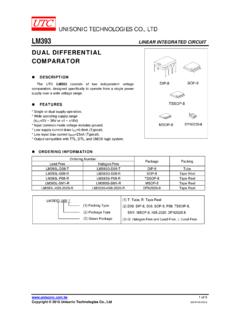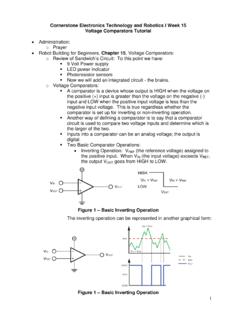Transcription of Low-power, dual-voltage comparators
1 February 2016 DocID2164 Rev 15 1/21 This is information on a product in full production. LM193, LM293, lm393 Low-power, dual - voltage comparators Datasheet - production data Features Wide single-supply voltage range or dual supplies: 2 V to 36 V or 1 V to 18 V Very low supply current ( mA) independent of supply voltage (1 mW/comparator at 5 V) Low input bias current: 20 nA typ. Low input offset current: 3 nA typ. Low input offset voltage : 1 mV typ. Input common-mode voltage range includes ground Low output saturation voltage : 80 mV typ.
2 (Isink = 4 mA) Differential input voltage range equal to the supply voltage TTL, DTL, ECL, MOS, CMOS compatible outputs Available in DFN8 2x2, MiniSO8, TSSOP8, and SO8 packages Description The LM193, LM293, and lm393 devices consist of two independent low voltage comparators designed specifically to operate from a single supply over a wide range of voltages. Operation from split power supplies is also possible. These comparators also have a unique characteristic in that the input common-mode voltage range includes ground even though operated from a single power supply voltage .
3 Contents LM193, LM293, lm393 2/21 DocID2164 Rev 15 Contents 1 Schematic diagram .. 3 2 Package pin connections .. 4 3 Absolute maximum ratings and operating conditions .. 5 4 Electrical characteristics .. 7 5 Electrical characteristic curves .. 8 6 Typical applications .. 9 7 Package information .. 12 DFN8 2x2 package information .. 13 MiniSO8 package information .. 15 TSSOP8 package information .. 16 SO8 package information .. 17 8 Ordering information .. 18 9 Revision history .. 19 LM193, LM293, lm393 Schematic diagram DocID2164 Rev 15 3/21 1 Schematic diagram Figure 1: Schematic diagram (1/2 LM193) Package pin connections LM193, LM293, lm393 4/21 DocID2164 Rev 15 2 Package pin connections Figure 2: Pin connections (top view) 1.
4 The exposed pad of the DFN8 2x2 can be left floating or connected to ground LM193, LM293, lm393 Absolute maximum ratings and operating conditions DocID2164 Rev 15 5/21 3 Absolute maximum ratings and operating conditions Table 1: Absolute maximum ratings Symbol Parameter Value Unit VCC Supply voltage 18 or 36 V Vid Differential input voltage 36 Vin Input voltage to 36 Output short-circuit to ground (1) Infinite Rthja Thermal resistance junction to ambient (2) DFN8 2x2 57 C/W MiniSO8 190 TSSOP8 120 SO8 125 Rthjc Thermal resistance junction to case (2) DFN8 2x2 MiniSO8 39 TSSOP8 37 SO8 40 Tj Maximum junction temperature 150 C Tstg Storage temperature range -65 to 150 ESD class (3) HBM.
5 Human body model (4) H1B MM: machine model (5) M2 CDM: charged device model (6) C5 Notes: (1)Short-circuits from the output to VCC+ can cause excessive heating and potential destruction. The maximum output current is approximately 20 mA independent of the magnitude of VCC+. (2)Short-circuits can cause excessive heating and destructive dissipation. Values are typical. (3)ESD class definition from AEC-Q100: (4)HBM class H1B: ESD voltage level from 500 V to 1000 V (5)MM class M2: ESD voltage level from 100 V to 200 V (6)CDM class C5: ESD voltage level greater than 1500 V.
6 Absolute maximum ratings and operating conditions LM193, LM293, lm393 6/21 DocID2164 Rev 15 Table 2: Operating conditions Symbol Parameter Value Unit VCC Supply voltage (VCC+) - (VCC-) 2 to 36 V Vicm Common mode input voltage range (VCC+ = 30 V) (1) Tamb = 25 C 0 to (VCC+) - Tmin Tamb Tmax 0 to (VCC+) - 2 Toper Operating free-air temperature range LM193, LM193A -55 to 125 C LM293, LM293A -40 to 105 lm393 , LM393A 0 to 70 Notes: (1)The input common-mode voltage of either input signal voltage should not be allowed to go negative by more than V.
7 The high end of the common-mode voltage range is (VCC+) - V, but either or both inputs can go to 30 V without damage. LM193, LM293, lm393 Electrical characteristics DocID2164 Rev 15 7/21 4 Electrical characteristics Table 3: VCC+ = 5 V, VCC- = 0 V, Tamb = 25 C (unless otherwise specified) Symbol Parameter Condition LM193A, LM293A, LM393A LM193, LM293, lm393 Unit Min. Typ. Max. Min Typ. Max. Vio Input offset voltage (1) 1 2 1 5 mV Tmin Tamb Tmax 4 9 Iio Input offset current 3 25 3 50 nA Tmin Tamb Tmax 100 150 Iib Input bias current (I+ or I-) (2) 20 100 20 250 Tmin Tamb Tmax 300 400 Avd Large signal voltage gain VCC = 15 V, RL = 15 k , Vo = 1 V to 11 V 50 200 50 200 V/mV ICC Supply current (all comparators ) VCC = 5 V, no load 1 1 mA VCC = 30 V, no load Vid Differential input voltage (3)
8 VCC+ VCC+ VOL Low-level output voltage Vid = -1 V, Isink = 4 mA 80 400 80 400 mV Tmin Tamb Tmax 700 700 IOH High-level output current VCC = Vo = 30 V, Vid = 1 V nA Tmin Tamb Tmax 1 1 A Isink Output sink current Vid = 1 V, Vo = V 6 18 6 18 mA tre Response time (4) RL = k connected to VCC+ s trel Large signal response time RL = k connected to VCC+, el = TTL, V(ref) = V 300 300 ns Notes: (1)At output switch point, Vo = V, Rs = 0 with VCC+ from 5 V to 30 V, and over the full common-mode range (0 V to (VCC+) - V).
9 (2)The direction of the input current is out of the IC due to the PNP input stage. This current is essentially constant, independent of the state of the output, so no loading charge exists on the reference of input lines. (3)Positive excursions of input voltage may exceed the power supply level. As long as the other voltage remains within the common-mode range, the comparator will provide a proper output state. The low input voltage state must not be less than V (or V below the negative power supply, if used).
10 (4)The response time specified is for a 100 mV input step with 5 mV overdrive. For larger overdrive signals, 300 ns can be obtained. Electrical characteristic curves LM193, LM293, lm393 8/21 DocID2164 Rev 15 5 Electrical characteristic curves Figure 3: Supply current vs. supply voltage Figure 4: Input current vs. supply voltage Figure 5: Output saturation voltage vs. output current Figure 6: Response time for various input overdrives - negative transition Figure 7: Response time for various input overdrives - positive transition LM193, LM293, lm393 Typical applications DocID2164 Rev 15 9/21 6 Typical applications Figure 8: Basic comparator Figure 9: Driving TTL Figure 10: Low-frequency op amp (1) Figure 11: Driving CMOS Figure 12: Low-frequency op amp (2) Figure 13.













